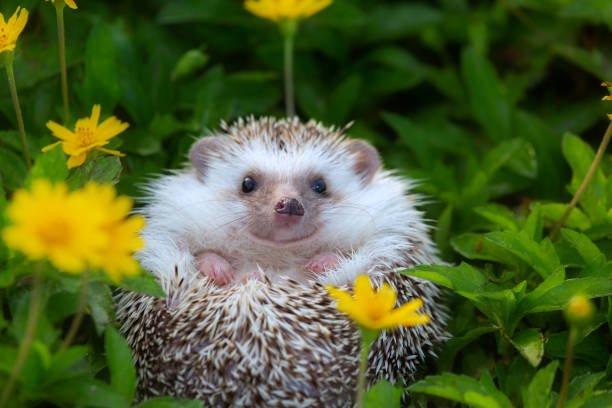Care Instructions for Hedgehogs as Pets.
Once properly socialized and cared for, hedgehogs have the potential to become wonderful pets. It’s common knowledge that keeping a hedgehog as a pet will keep you entertained and busy far into the night.
Remember that they do need a great lot of attention and care on your part. For the animals’ best possible health, their enclosure will need to be cleaned on a consistent basis, and they should be given high-quality food.
Find Out Everything You Can Before Bringing Home a Hedgehog
Only one of the seventeen distinct species of hedgehogs may be kept as a pet, therefore it’s important to do your research before purchasing one. The African pygmy hedgehog is the species that is most often seen for sale in pet shops.
It shouldn’t come as much of a surprise that hedgehogs are gaining in popularity given that they have such a cute and lovable look. On the other hand, pet owners often make the same error.
They do not educate themselves about hedgehogs before bringing one into their house. This results in improper care for the hedgehog as well as the acquisition of animals from breeders that cannot be trusted, amongst other issues.
Before you even think of obtaining a hedgehog as a pet, you need educate yourself about a few of the most important aspects of these rodents.
The manner in which you provide care for your hedgehog, including its housing, enrichment, health, grooming, and handling, is directly tied to the specific requirements of this species.
Personality and Intellectual Development
Because they are nocturnal creatures, hedgehogs are awake at night and asleep during the day. This implies that they are most active when it is dark outside.
They are also incredibly active, which means that if you confine them in a cage and don’t give them something to do, you will end up with a pet that is quite unhappy.
They have a tendency to be quite shy and, when they are scared, they need someplace to hide in. Successfully caring for your hedgehog requires creating an environment that is suited to the individual characteristics of your pet.
To prevent your hedgehog from becoming overweight and to ensure that it maintains a healthy habit, it is necessary to fulfill its daily activity requirements on a consistent basis.
A nice option would be to supply a wheel that was designed for a rat or chinchilla, provided that it has a diameter of at least 12 inches and a smooth, flat surface.
Toys designed for cats, such as little balls that are solid and not made of wire, and tunnels, are equally fun for hedgehogs.
The cardboard core that is found in rolls of toilet paper or paper towels may be used to create an inexpensive and fun toy for your hedgehog that you can make yourself.
You can also construct a simple foraging toy by putting some strips of fleece and fabric in a box or bowl and then sprinkle some food treats inside of the box or bowl.
There is an interesting pattern of conduct that you need to keep an eye out for. Hedgehogs will froth at the mouth and spread saliva all over their backs if they are presented with a new smell or meal.
This behavior is shown by hedgehogs for reasons that are not fully understood, and some hedgehogs engage in it more often than others. However, there is no need to be worried about this matter. Do not freak out if you see this behavior for the very first time since it is typical and frequent.
Handling Your Hedgehog
The very first thing you need to be aware of is that domesticated hedgehogs have the exact same physical characteristics as their wild counterparts.
This indicates that they are covered with quills, and there are a lot of them! If you touch a hedgehog, you are going to be poked by its quills at some time, no matter how gently you do it.
To tame a hedgehog and maintain the relationship after it has been established, you must engage with it on a regular basis.
You should try to keep these sessions brief in order to socialize them without putting them under an excessive amount of stress. Hedgehogs that have not been properly socialized are more likely to bite when they feel trapped or threatened.
If you want to get a hedgehog acquainted to you, one tip is to put something familiar in their enclosure, such as an old T-shirt, sweatshirt, towel, or blanket. They will get used to the smell of you if you cuddle up to them in it.
Always use both hands when scooping up and holding a hedgehog to ensure that they feel as if they have complete support.
To begin, it is recommended that you wrap your hands in a towel while handling your hedgehog so that you are not injured by their quills until they get used to you.
Your hedgehog will also thrive more if it is allowed time regularly outside of its enclosure to forage and investigate. You should only do this when you have the time to sit down and watch them, and you should make sure that none of your other pets are around.
After having any kind of contact with a hedgehog, you should always make sure to give your hands a good scrub after you’re done.
In addition to this, you should never bring the hedgehog to close your lips in an attempt to give it a kiss. Handling hedgehogs may pose a risk of salmonella infection, according to research conducted by the Centers for Disease Control and Prevention (CDC).
You should also never allow the hedgehog go anyplace where food is cooked, such as around the kitchen or on the dining table. This includes both of those places.
Diet
Hedgehog accompanied with a dish of food
Hedgehogs, while living in the wild, are constantly on the lookout for and consuming various insects. In order for hedgehogs to maintain their health, they must consume a specific diet that includes protein, lipids, and fiber.
Hedgehogs may consume dry kibble designed for adult cats as long as it has a reduced-calorie formula. However, a pre-made commercial diet designed specifically for hedgehogs is available for purchase.
Cat food is recommended by some sources for the diet of hedgehogs; however, not all specialists agree with this recommendation, at least not when it comes to the hedgies’ primary source of nutrition.
Your hedgehog should always have access to clean, fresh water that is contained in a dish that is hefty and cannot be easily tipped over.
Cage bottles may be used to provide them with water, but it is not suggested since there is a risk that the cage bottles can harm their teeth. However, it is possible for this to happen.
When and how often a hedgehog should be fed
Due to the fact that hedgehogs are nocturnal, the best time to feed them is in the evening when they are up and active. There are some owners that provide their hedgehog’s free food, although this practice is not encouraged owing to the risk of obesity.
They should cut down on their consumption in order to prevent developing obesity, which is a severe health risk. Toys that simulate the search for food are an excellent option for giving to a child along with their meal.
These things make it possible for the hedgehog to participate in natural behaviors that may have a calming impact while also boosting its mental and physical health as a whole.
Their food and water dishes in their cage should ideally be made of ceramic and should be able to resist tipping over. It is not advisable to use cage bottles because of the potential damage they may do to their teeth.
There is not a very high caloric demand placed on hedgehogs. Most may be given between one and two tablespoons of kibble on a daily basis, but you should monitor their consumption initially to ensure that they are not getting an excessive amount of food. Examine the remaining food in their dish after they have finished eating to determine the appropriate portion size to give them.
Supplements to the Diet
diet for the hedgehog consist of finely diced chicken and cucumbers
In addition to the dry kibble that they eat, you should provide your hedgehog a range of other foods and treats, such as the following:
- One spoonful worth of dark, leafy vegetables that have been chopped up into readily digestible bits and eaten three to four times per week is recommended. Greens such as arugula, collard greens, dandelion greens, romaine lettuce, and spinach are all excellent options.
- They will also like fresh asparagus, broccoli, carrots, radishes, sweet potatoes, and turnips that have been sliced up and served to them.
- You should not feed your pet more than three to four times a week either live or frozen insects like crickets, mealworms, waxworms, or silkworms.
- Fresh meats that have been baked, roasted, or boiled, such as chicken, tuna, or salmon, served in small pieces without any seasoning and no more than a few times a week in an effort to prevent obesity.
- Fresh fruits in limited quantities, with an emphasis on low-sugar options wherever possible. Apples, bananas, berries, cherries, melons, peaches, and pumpkins are some examples of the kinds of fruits that are suitable for hedgehogs.
- Baby food (for humans), consisting of around one to two teaspoons spread out over the course of many days each week. Choose items that are in stage 2 or below since those in higher stages have a larger concentration of sugar.
- A few times each week, you may give your pet a spoonful of eggs that have been cooked or scrambled.
Foods to Stay Away From
There are plenty of things that hedgehogs are unable to consume. Do not give the following to your pet if you do not want to make it sick:
They are lactose intolerant, thus they cannot consume anything that contains dairy ingredients. Once a week, you might feed them a spoonful of yogurt or cottage cheese, but you should stop doing so if you detect any stomach trouble or diarrhea.
- Avoid high-fat, high-calorie foods like beef in favor of leaner cuts of meat and fish whenever possible.
- Wild-caught insects or those purchased from a store that sells fish bait. Feed your hedgehogs only insects that have been specifically deemed safe for them by a reputable pet retailer.
- A number of fruits, such as grapes, raisins, citrus fruits, pineapples, and avocados, are known to be poisonous.
- Garlic, mushrooms, onions, potatoes, and tomatoes are among the list of vegetables that hedgehogs should avoid eating.
- Hedgehogs should never be fed any form of nut, under any circumstances.
- As a rule, the formulations used for making kibble for kittens include an excessive amount of fat. Hedgehogs are better off eating adult food for cats that is lower in calories.
- Never give your hedgehog chocolate or any other human sweets or candies to eat.
Conditions imposed on housing
Hedgehogs are solitary animals, thus they need their own space in the enclosure at all times. It is not recommended to house them with any other animals. They should only be housed with other hedgehogs if they have been raised with them from the time they were born.
The bare minimum dimensions for the enclosure are a width of two feet and a length of four feet. It is to your advantage to make as much room as you can. The cover needs to be made of mesh so that there is no obstruction to the free movement of air.
Wire floors may injure a hedgehog’s feet. Choose an enclosure that already has a floor, such as an aquarium or a cage designed for guinea pigs, as an alternative.
A single-level enclosure is preferable to a multi-level one since it is less likely that a hedgehog may damage itself by falling between levels. It is important to keep the cage away from regions that have loud sounds and drafts of chilly air.
Put the cage in a quiet place with low lighting that has a temperature ranging from 60 to 30 degrees Celsius (140 to 50 degrees Fahrenheit).
To keep your hedgie from becoming too hot, the cage shouldn’t be placed where it will be exposed to direct sunlight. When they are feeling overwhelmed, you should give them with a box or a hiding place so that they may sleep or flee to their favorite location.
As well as a Substrate and Bedding
It is important that you give your hedgehog bedding that is both soft and comfy. The use of cotton, corduroy, flannel, or fleece for the construction of cage liners is a viable option.
You may also cut the cloth on your own, but you should check to make sure there are no ends that are frayed. In order to maintain the cleanliness of your pets, you will need to change their bedding every day.
The substrate that you choose for the bottom of your cage should be gentle and free of any sharp or jagged pieces that might injure your fragile hedgehog. It is not suggested to use wood shavings of any kind, including pine, cedar, or aspen.
There is also bedding available that is made from recycled paper, soft fiber, or pelleted materials; all of these are excellent options. These should be replaced on a regular basis in order to maintain the cleanliness of the cage.
Hedgehogs are timid animals, thus it is essential that their enclosure provide them with areas in which they may conceal themselves and feel secure.
You may either go to a pet shop and buy ready-made hiding places like as plastic igloos and sleeping pouches, or you can create your own hiding places using tiny boxes or a short length of PVC pipe.
They also like to bury themselves and hide beneath the bedding, so providing them with a space that has multiple different sheets of cloth might be another alternative.
Personal Hygiene and Bathing
To maintain their cleanliness, you will need to give your hedgehog a wash on a regular basis. They are essentially strolling around in their own saliva, urine, and excrement while they are confined in their cage.
You may give your hedgehog a bath in the sink of either your kitchen or bathroom and then use a gentle toothbrush and shampoo designed specifically for hedgehogs to clean their quills.
Because you don’t want your freshly washed hedgehog to get a chill while they’re still wet, you should carry it about with you while it’s wrapped in a warm towel until it’s dry. In addition, it is essential to do routine nail trimmings using some tiny rodent cutters.
Problems of Health That Are Common in Hedgehogs
The average lifetime of a hedgehog is between four and six years. In order to provide the best possible care for your hedgehog, you need to be aware of the following medical concerns:
- The condition of the neurological system known as wobbly hedgehog syndrome is now incurable and treatment options are limited. It is a congenital disease that might make it difficult for your pet to maintain their equilibrium.
- “Spitballs” or “self-anointing” are the terms used to describe what happens when a hedgehog smells something that causes it to respond reflexively. As a defensive mechanism, the hedgehog will cover its quills with saliva. It is not a true medical emergency, but if you observe your hedgehog acting in this manner, you should think about what smell is causing it and try if you can get rid of it or at least minimize its exposure to it.
- Hedgehogs often have a problem with becoming overweight.
- Bloat is a condition that may occur in hedgehogs when they have an excessive amount of gas in their intestines.
- Inappropriate eating may cause clogs in the digestive tract, which can lead to health problems.
- Hedgehogs often suffer from pneumonia and other respiratory conditions, particularly if they are subjected to anything that contains ammonia. When disinfecting and cleaning your hedgehog’s cage and the spaces around it, you should always use cleansers that are on the milder side.
Hedgehogs, especially as they mature, often suffer from heart disease.
To prevent gingivitis and other gum diseases, hedgehogs need regular dental care. Failing to do so may lead to the development of these conditions. Visits to the dentist may aid in the early detection of malignancies in the mouth, which can prevent the disease from progressing further.
Hedgehogs are susceptible to a variety of parasitic diseases, including as mange, ringworm, fleas, and mites.
Hedgehogs lose their quills at least twice during their lifetime, and each time they do, the process may cause their skin to become dry and sensitive. You may keep them comfy by applying coconut or olive oil to their skin. Olive oil also works.
Locating a Competent Veterinarian
Perform some research on the local vets before taking a hedgehog into your house. Some veterinarians have a difficult time comprehending the physiology and medicinal requirements of hedgehogs. In the event that your hedgehog is sick, you don’t want to be in a position where you can’t take it to the veterinarian.
Write down the names and phone numbers of one or two veterinarians and post them on your refrigerator or some other secure location just in case you end up needing them.
Concerns Relating to the Law
Hedgehogs are regarded as exotic animals, which means that in some jurisdictions it is against the law to acquire one and in others, there are ownership limitations.
In the states of California, Georgia, Hawaii, and Pennsylvania, as well as anywhere inside the five boroughs of New York City, it is against the law to possess a hedgehog.
You are allowed to own one in the states of New Jersey and Wisconsin, but you will need a permit or extra papers from your veterinarian.
Get Familiar with the Fundamentals Before You Bring One Into Your House
The upkeep of a hedgehog pet might be somewhat laborious. They have food requirements that must be met, must be socialized in a manner that is gradual and gentle, and must be housed in an area that is warm, clean, and provides places to hide and play.
Having a hedgehog as a pet may be a rewarding experience if you take the time to familiarize yourself with its care requirements and give it the attention it deserves.
Are Marshmallows Safe For Dogs To Eat?
5 Tips To Protect Dog Paws From Hot Pavement
Melon: Is It Safe For Dogs To Eat?
Is Cantaloupe Safe For Dogs To Eat?
Can Dogs Consume Grapes Without Any Harm?




